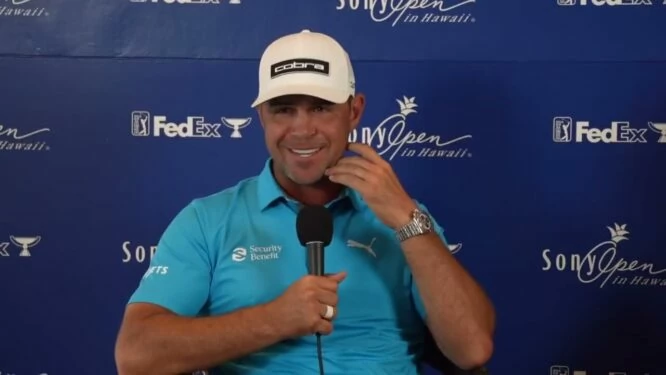Gary Woodland returns to competition this week at the Sony Open just four months after undergoing a very delicate operation on his brain. Doctors removed a tumour the size of a baseball from his brain. The account of the 2019 US Open champion at Pebble Beach is absolutely chilling. “I’ve spent four and a half months thinking every day that I was going to die,” he explained in the run-up to the Hawaii tournament of the PGA Tour.
It all started two weeks after the Masters of Augusta. He was playing the Mexico Open at Vidanta. In the middle of the night, Woodland had a seizure, jumped in bed and woke up shaking, terrified. The feeling was very strange. Nothing like this had ever happened to him before. The episodes kept repeating over time. “I didn’t feel like myself. There were many seizures, especially in the middle of the night. Tremors. My hands were shaking a lot. A lot of fear. That’s what scared me the most, because I’m a very optimistic person, I always think good things are going to happen, but I was very scared every day, especially about death,” he recounted.
Obviously, the main feeling after those first episodes was uncertainty and confusion. He didn’t know what was happening to him. “As it got worse, I started to lose my appetite, I had chills, I had no energy. It started to get so bad that I called my doctor, who I’ve been with for thirteen years, and asked for something to calm me down. It was a terrible feeling of anxiety. I was shaking a lot and wanted to rule out Parkinson’s. They did an MRI that night (24 May, a month after the first symptoms) and a lesion came up. It looked like a tumour in my brain. They started doing more tests, more MRIs and took me to a specialist in Kansas City who explained everything very well. The jolts and everything I was experiencing at night were partial seizures. The lesion in my brain was in the area that controls fear and anxiety. He told me: “You’re not going crazy. Everything that’s happening to you is normal because of the tumour”. He gave me a medication for anxiety. The seizures continued, so they increased the dose. Once they increased the dose it started to go down. I started to lose memories. I started to do a lot of weird things, but the only thing they were worried about was the fear and anxiety. When they increased the medication my brain started to slow down and the seizures started to stop. That was good because I could function during the day. The medications worked for the seizures, but had horrible side effects. The fear came back two weeks later and I talked to the doctors again. That’s when they told me they had to go into my brain. They thought the lesion was growing and putting more and more pressure. The worst thing was the fear of death. It was four and a half months thinking every day that I was going to die. Whether I was driving or flying, I imagined different ways of dying. At the Memorial I woke up one night with a seizure and spent an hour gripping the sides of the bed thinking I was falling from heights and going to die”.
Five months after the first seizure, Woodland went to see a specialist in Miami who recommended surgery. “We can keep increasing the medicine, but it’s not stopping the fear. Doing a biopsy is too risky because of where the lesion is. I didn’t want to go in more than necessary. So surgery and removal was the next step. They couldn’t get it all out, but the good news is that it was benign. If it had been cancerous they would have removed it all. They didn’t because it was in a delicate area, resting on my optic nerve and related to the mobility of the left side of my body. If something went wrong I could lose my sight or become paralysed on one side. You can imagine the fear I went into the operating room with”.
The operation was a success. He spent two days in the ICU and then walked out of the hospital, got into a car and went home. “The first feeling when I woke up from the operation was relief because I was alive, I could see well and I could move the left side of my body. Now I have MRIs every three months. I had one a week and a half ago and everything was stable since the operation,” he commented.
Woodland spent a month on the sofa after the operation. Two days after returning from the hospital he installed a putt simulator in his living room. The half hour of energy he had each day he spent putting. “The hardest thing was seeing the fear in my six-year-old son’s face. I tried to always have my head covered, but when he saw the staples and then the scar he was scared. He thought I was going to die”. Five weeks later he started to do the full swing and hit balls. Now he is excited and grateful for the chance to play a tournament again.
Many will wonder how he was able to play golf in those months while the episodes with the seizures and fears were happening. “I was actually playing really good golf and it was the only time of the day when I didn’t think about what was happening off the field. For me golf was like a balm, even though sometimes I forgot the club I was hitting or thought I was spending too much time on the ball. The results were good, even though it consumed all my energy. There came a point where I had to stop competing, but even in those weeks before the operation, I would go hit balls for five or six hours because it relieved me, it made me think about something else,” he pointed out.
Woodland has been playing golf before travelling to Hawaii. He has spoken with Butch Harmon and has played some rounds, always competing as a team, alongside Matt Kuchar, the golfer who has been closest to him during this time. The technical part is fine, his big challenge is the mental aspect. “I want to see how my brain reacts to a week of concentration and pressure. That’s what worries me the most,” he assured.
In principle, the tumour seems under control. It is assumed that all the blood vessels have been resected and it is dead, so it should not grow back, but he will have to continue having tests. Meanwhile, the great lesson Woodland takes from all this is that “there are many good things in life and many good people willing to help you when you are having a hard time. You should not be afraid or embarrassed to ask for help because people are good. I don’t want this to be a bump in my life. I want it to be a leap in my career. I’m here because I believe I was born for this, to play great golf. I want to do it again. Nothing is going to stop me. I believe in that. I believe that many great things are yet to come,” he concluded.




